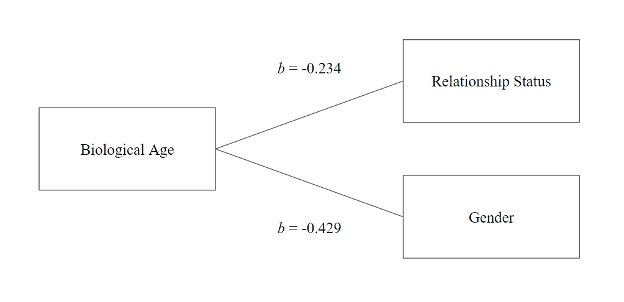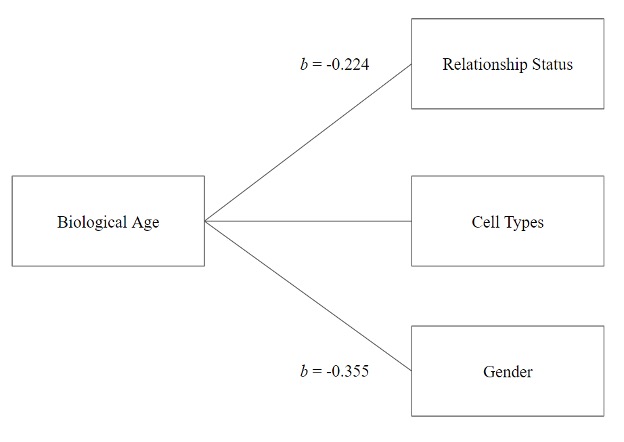The Effects of Relationship Status on Epigenetic Aging
by Kelly Luo, Sociology
Abstract: Biological age is a measure of aging that is dependent on epigenetic alteration, and it can act as a predictor of early mortality. Increased stress has been associated with accelerated biological aging, but a healthy marriage has been seen to reduce the negative effects from stressors. This study examines the relationship between the marital status of 348 low-income Black Americans and biological aging using data from the Promoting Strong African American Families (ProSAAF) project. Multiple regression analysis was performed to assess the relationship between marital status and biological aging while controlling for gender and different cell types. The results of the study suggested that individuals who were married were more likely to have a lower biological age than individuals who were not married.
epigenetic aging, marital status, accelerated aging
Epigenetic clocks have been used to distinguish between an individual’s chronological age and biological age (Levine & Crimmins, 2018). While chronological age refers to the amount of time someone has lived, biological age is a physiological degree of aging determined using DNA methylation, a heritable biological process of adding methyl groups to DNA. These DNA methylation patterns occur throughout the human genome, and they can be impacted by factors such as social environments, diet, disease, and lifestyle. In general, epigenetic aging is marked by overall global hypomethylation and hypermethylation of CpG islands, which are cytosine and guanine nucleotides separated by one phosphate group (Johnson et al., 2012). Psychological stress and stress-related disorders, in particular, have also been linked to accelerated biological aging and early mortality (Palma-Gudiel et al., 2020).
In the United States, Black Americans experience greater health disparities compared to other racial groups due to their social conditions (Williams & Rucker, 2000). African Americans also have a higher rate of individuals with age-related diseases and a shorter average life expectancy compared to other ethnic groups (Luo et al., 2022). The lack of social benefits that African Americans experience compared to their White counterparts has also led to inequities regarding their social determinants of health, such as employment, education, and access to healthcare. The increased stress and overall decreased well-being that Black Americans experience can be associated with premature biological aging.
In 2022, 17.1 percent of Black Americans were living in poverty compared to 8.6 percent of White Americans (U.S. Census Bureau, n.d.). Individuals with lower incomes can have difficulty accessing healthcare and may experience environmental factors that lead to worse overall health compared to individuals with higher incomes. Americans living in impoverished communities have a higher risk for chronic diseases, mental illnesses, and lower life expectancy due to factors such as difficulty paying for insurance and medication, increased violence in the community, and a lack of access to healthy food (Braveman et al., 2010). All of these contribute to the heightened stress that impoverished individuals experience, causing them to be more prone to accelerated biological aging.
Being in a healthy marriage can help to alleviate some of the strain brought on by these chronic stressors. It is theorized that depending on the marital strengths and strains of the relationship, individuals can experience different impacts on their physical health (Slatcher & Selcuk, 2017). Partners that are responsive and supportive can buffer the negative effects from outside stressors compared to partners that are unresponsive. Black Americans have low marriage rates and a divorce rate of almost double that of White Americans (Raley et al., 2015). Recent studies have shown that healthier romantic relationships for Black Americans led to increased couple support, subsequently correlating with reduced inflammatory responses (Beach et al., 2019).
However, it is unclear whether marital status is associated with decelerated biological aging. To expand on this discovery, the current study will examine the impacts that marital status has on the biological aging of low-income Black Americans. We expect low-income Black Americans who are married to have a lower biological age compared to those who are not married due to the diminished effects of chronic stressors. Moreover, this effect will remain even when controlling for confounding variables such as gender and cell-type composition.
Methods
Sample
This research used data from the Promoting Strong African American Families (ProSAAF) project, a program that used preventative measures to enhance supportive couple relationships in low-income African American families living in the rural Southern United States (Barton et al., 2018). All study procedures were approved by the University Institutional Review Board (Study title: Protecting Strong African American Families, approval number 2012104112). ProSAAF is an in-home program dedicated to teaching couples how to effectively communicate to properly handle stressors that impact African American couples. In the program, an African American facilitator conducted an intervention session for each couple for 6 consecutive weeks. The program followed 346 couples, or 692 individuals, in a longitudinal study in which follow-up assessments were conducted after 9 months, 17 months, and 24.5 months, where participants would complete measures online. After 6 years, participants had their blood samples drawn to be assayed for genome-wide DNA methylation. Among those who consented to participate, 88% (n = 348) of the individuals involved in the 6-year follow up successfully underwent assessment, forming the current study sample. The average age of participants after the 6-year follow up was 44.61 years, with women averaging 43.02 years and men averaging 46.49 years. Additional detail regarding samples are described by Lei and Beach (2023).
Measures
Accelerated Biological Aging. The accelerated pace of aging was measured using GrimAge, an epigenetic clock that uses DNA methylation (McCrory et al., 2021). Compared to other epigenetic clocks, GrimAge measures accelerated aging by examining the DNA methylation of 12 plasma proteins, which predicted 1030 CpG sites that predict a person’s biological age using time-to-death data. GrimAge was analyzed using the online “New Methylation Age Calculator” with the advanced analysis option and the “normalize data” (Horvath S., 2013). To convert GrimAge into a measure of accelerated aging, GrimAgeAccel was generated by deriving unstandardized residual scores from the regression of GrimAge on chronological age. These residuals showed a mean of zero and reflected both positive and negative deviations of chronological age in years. Positive scores indicated accelerated aging.
Marital Status. Marital status was measured using a binary variable, where a value of 1 represented that the participants was married, and a value of 0 indicated that the respondent was not married.
Covariates
Gender was controlled for (1 = females and 0 = males) and cell-type composition was measured through the “EstimateCellCounts” function in the “minfi” Bioconductor package (Aryee et al., 2014), using the reference-based method by Houseman et al. (2012). The current study estimated proportions for CD4+ T cells, CD8+T cells, Natural Killer cells, B cells, and monocytes in whole blood. These proportions were controlled to examine the relationship between marital status and accelerated biological aging, minimizing confounding influences from cell-type variation. Thus, the associations reflect “intrinsic” accelerated aging measures, relatively independent of individual differences in cell types.
Analytic strategy
To examine the relationship between accelerated aging and marital status, a simple linear regression model was generated in R Statistical Software (v4.3.0; R Core Team 2023). A multiple linear regression analysis from the R stats package was used to see the relationship between accelerated aging along with marital status and gender (R Core Team, 2023). To incorporate the impact of different cell types on accelerated aging, another multiple linear regression analysis was conducted between accelerated aging along with relationship status, gender, CD8+ T cell counts, CD4+ T cell counts, Natural killer (NK) cell counts, B cell counts, Monocyte cell counts, and Gran cell counts. The mean, standard deviation, and median for the variables of age, relationship status, gender, and all cell counts were also calculated using the R stats package (R Core Team, 2023).
Results
The participants in the study were generally middle-aged adults (x̄ = 44.61 years, SD = 8.27, Table 1). The majority of the individuals in the study are married (60.830%); the mean of the marital status of the participants was 0.61, with 1 indicating that the individual is married and living together and 0 indicating that the individual is not married and/or not living together. 45.994% of participants are male while 54.006% of participants are female.

Figure 1. A visual depiction of Model 1 illustrating the relationship between biological age and relationship status

Figure 2. A visual depiction of Model 2 illustrating the relationship between biological age, relationship status, and gender

Figure 3. A visual depiction of Model 3 illustrating the relationship between biological age, relationship status, gender, and multiple cell types
To uncover potential relationships between variables, various regression analyses were performed (Table 2). Model 1 reveals that relationship status is significantly and negatively associated with GrimAgeAccel (b = -0.220, p = 4.7e-5) (Figure 1). In Model 2, both marital status (b = -0.234, p = 1.67e-6) and gender (b = -0.429, p < 0.001) are seen to be significantly associated with GrimAgeAccel (Figure 2). Model 3 shows that marital status (b = -0.224, p = 2.57e-6), gender (b = -0.355, p = 1.76e-10), and all cell types are significantly associated with biological age (Figure 3). The results suggest that being married can predict decelerated biological aging even control gender and cell-types compositions.
Table 1. Descriptive statistics for study variables
| Variables | Mean | SD | Median |
| Age Marital Status Gender | 44.607 0.608 0.540 | 8.271 0.489 | 43 1 1 |
| CD8+ T cells CD4+ T cells | 0.075 0.188 | 0.049 0.071 | 0.070 0.189 |
| NK cells B cells | 0.024 0.073 | 0.033 0.034 | 0.009 0.067 |
| Monocytes Granulocytes | 0.057 0.599 | 0.028 0.109 | 0.055 0.597 |
Table 2. Regression models examining the effects of marital status on accelerated biological aging
| Model 1 | Model 2 | Model 3 | ||||||
| b | p-value | b | p-value | b | p-value | |||
| Marital status | -0.220 | 4.7e-5 | -0.234 | 1.67e-6 | -0.224 | 2.57e-6 | ||
| Gender | -0.429 | 2e-16 | -0.355 | 1.76e-10 | ||||
| CD8+ T cells | 0.495 | 0.046 | ||||||
| CD4+ T cells | 0.920 | 0.015 | ||||||
| NK cells | 0.407 | 0.014 | ||||||
| B cells | 0.458 | 0.010 | ||||||
| Monocytes | 0.382 | 0.014 | ||||||
| Granulocytes | 1.546 | 0.006 | ||||||
| R2 | 0.044 | 0.225 | 0.276 | |||||
Discussion
The regression models performed in this study analyze the correlation between marital status and other variables and accelerated aging. In Table 2, Model 1 shows that marital status has a significant effect on decelerated aging (β = −0.220, p = 4.7e-5), which shows that being married contributes to successful aging. Given that a value of 0 for marital status indicates that an individual is not married and/or not living together, this suggests that Black Americans who are not married will have a higher biological age compared to those who are married. This aligns with the hypothesis that married Black American individuals will have a lower biological age on average.
Similarly, Model 2 also has a significant interaction between accelerated aging and gender (β = −0.429, p = 2e-16), suggesting that married individuals are associated with having a lower biological age. Given that a value of 0 for gender indicates a male and a 1 indicates a female, these results show that males are correlated with having a higher biological age and more accelerated aging compared to females.
Model 3 has a negative beta coefficient and a statistically significant p-value between accelerated aging and CD8+ T cells, CD4+ T cells, NK cells, B cells, monocytes, and granulocytes(two-way ANOVA, p=2e-16). The results from Model 3 reaffirm that married individuals and females are associated with a lower biological age, but individuals with higher amounts of each cell type are also associated with a higher biological age. The significant interactions between the different cell types and accelerated biological age show the importance of controlling for cell type composition in the analyses.
The results of the analyses support the hypothesis that low-income, married Black Americans have a lower biological age and have decelerated biological aging compared to low-income, unmarried Black Americans. This implies that marital status could lessen the effects of stressors from a low-income community that may accelerate biological aging, so projects such as ProSAAF that work to enhance relationships can potentially be used in the future to decelerate the rate of biological aging for low-income individuals.
The study only examines the findings from low-income Black Americans, so future studies should look to replicate these results using a sample of similar low-income groups with more racial and ethnic diversity to ensure consistency between studies. Additional studies could also expand on the current study by researching if there is a difference in the correlation between different types of relationship statuses, such as married, divorced, and cohabiting, and biological aging.
References
Aryee, M. J., Jaffe, A. E., Corrada-Bravo, H., Ladd-Acosta, C., Feinberg, A. P., Hansen, K. D., & Irizarry, R. A. (2014). Minfi: a flexible and comprehensive Bioconductor package for the analysis of Infinium DNA methylation microarrays. Bioinformatics, 30(10), 1363–1369. https://doi.org/10.1093/bioinformatics/btu049
Barton, A. W., Beach, S. R. H., Wells, A. C., Ingels, J. B., Corso, P. S., Sperr, M. C., Anderson, T. N., & Brody, G. H. (2018). The protecting strong African American families program: A randomized controlled trial with rural African American couples. Prevention Science, 19(7), 904–913. https://doi.org/10.1007/s11121-018-0895-4
Beach, S. R. H., Lei, M. K., Simons, R. L., Barr, A. B., Simons, L. G., Cutrona, C. E., & Philibert, R. A. (2019). Perceived relationship support moderates the association of contextual stress with inflammation among African Americans. Journal of Family Psychology, 33(3), 338–348. https://doi.org/10.1037/fam0000509
Braveman, P. A., Cubbin, C., Egerter, S., Williams, D. R., & Pamuk, E. (2010). Socioeconomic disparities in health in the United States: What the patterns tell us. American Journal of Public Health, 100(S1), S186–S196. https://doi.org/10.2105/AJPH.2009.166082
Horvath S. (2013). DNA methylation age of human tissues and cell types. Genome biology, 14(10), R115. https://doi.org/10.1186/gb-2013-14-10-r115
Johnson, A. A., Akman, K., Calimport, S. R., Wuttke, D., Stolzing, A., & de Magalhães, J. P. (2012). The role of DNA methylation in aging, rejuvenation, and age-related disease. Rejuvenation research, 15(5), 483–494. https://doi.org/10.1089/rej.2012.1324
Lei, M. K., & Beach, S. R. H. (2023). Neighborhood disadvantage is associated with biological aging: Intervention-induced enhancement of couple functioning confers resilience. Family Process, 62(2), 818–834. https://doi.org/10.1111/famp.12808
Levine, M. E., & Crimmins, E. M. (2018). Is 60 the new 50? Examining changes in biological age over the past two decades. Demography, 55(2), 387–402. https://doi.org/10.1007/s13524-017-0644-5
Luo, J., Hendryx, M., & Wang, F. (2021). Mortality disparities between Black and White Americans mediated by income and health behaviors. SSM – Population Health, 17, 101019. https://doi.org/10.1016/j.ssmph.2021.101019
McCrory C., Fiorito G., Hernandez B., Polidoro S., O’Halloran A. M., Hever A., Ni Cheallaigh C., Lu A. T., Horvath S., Vineis P., Kenny R. A. (2021). GrimAge outperforms other epigenetic clocks in the prediction of age-related clinical phenotypes and all-cause mortality. Journal of Gerontology Series A—Biological Sciences and Medical Sciences, 76(5):741-749. doi: 10.1093/gerona/glaa286. PMID: 33211845; PMCID: PMC8087266.
Palma-Gudiel, H., Fañanás, L., Horvath, S., & Zannas, A. S. (2020). Psychosocial stress and epigenetic aging. International Review of Neurobiology, 150, 107–128. https://doi.org/10.1016/bs.irn.2019.10.020
R Core Team. (2021). R: A language and environment for statistical computing. R Foundation for Statistical Computing, Vienna, Austria. https://www.R-project.org/.
Raley, R. K., Sweeney, M. M., & Wondra, D. (2015). The growing racial and ethnic divide in U.S. marriage patterns. Future child, 25(2), 89–109. https://doi.org/10.1353/foc.2015.0014
Slatcher, R. B., & Selcuk, E. (2017). A social psychological perspective on the links between close relationships and health. Current Directions in Psychological Science, 26(1), 16–21. https://doi.org/10.1177/0963721416667444
U.S. Census Bureau. (2022). Poverty status in the past 12 months. American Community Survey, ACS 1-Year Estimates Subject Tables, Table S1701. Retrieved December 20, 2023, from https://data.census.gov/table/ACSST1Y2022.S1701?q=s1701.
Williams, D. R., & Rucker, T. D. (2000). Understanding and addressing racial disparities in health care. Health Care Financing Review, 21(4), 75–90.
Citation Style: APA
